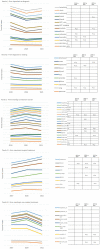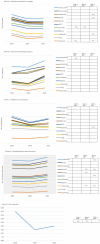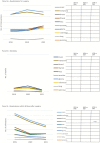Impact of COVID-19 on cancer care pathways in a comprehensive cancer center in northern Italy
- PMID: 37333533
- PMCID: PMC10275360
- DOI: 10.3389/fpubh.2023.1187912
Impact of COVID-19 on cancer care pathways in a comprehensive cancer center in northern Italy
Abstract
The COVID-19 pandemic burdened health care systems worldwide. Health services were reorganized with the dual purpose of ensuring the most adequate continuity of care and, simultaneously, the safety of patients and health professionals. The provision of care to patients within cancer care pathways (cCPs) was not touched by such reorganization. We investigated whether the quality of care provided by a local comprehensive cancer center has been maintained using cCP indicators. A retrospective single-cancer center study was conducted on eleven cCPs from 2019 to 2021 by comparing three timeliness indicators, five care indicators and three outcome indicators yearly calculated on incident cases. Comparisons of indicators between 2019 and 2020, and 2019 and 2021, were performed to assess the performance of cCP function during the pandemic. Indicators displayed heterogeneous significant changes attributed to all cCPs over the study period, affecting eight (72%), seven (63%) and ten (91%) out of eleven cCPs in the comparison between 2019 and 2020, 2020 and 2021, and 2019 and 2021, respectively. The most relevant changes were attributed to a negative increase in time-to-treatment surgery-related indicators and to a positive increase in the number of cases discussed by cCP team members. No variations were found attributed to outcome indicators. Significant changes did not account for clinical relevance once discussed by cCP managers and team members. Our experience demonstrated that the CP model constitutes an appropriate tool for providing high levels of quality care, even in the most critical health situations.
Keywords: COVID-19; cancer care; care pathway; pandemic management; quality management.
Copyright © 2023 Cigarini, Daolio, Caviola, Pellegri, Cavuto, Guberti, Mazzini and Cerullo.
Conflict of interest statement
The authors declare that the research was conducted in the absence of any commercial or financial relationships that could be construed as a potential conflict of interest.
Figures




References
-
- Gimbe evidence for health. (2022). Available at: https://coronavirus.gimbe.org/ (Accessed November 3, 2022)
-
- COVID-19: supporting oncology professionals. (2022). Available at: https://www.esmo.org/newsroom/covid-19-and-cancer/supporting-oncology-pr... (Accessed November 3, 2022)
Publication types
MeSH terms
LinkOut - more resources
Full Text Sources
Medical
Miscellaneous

